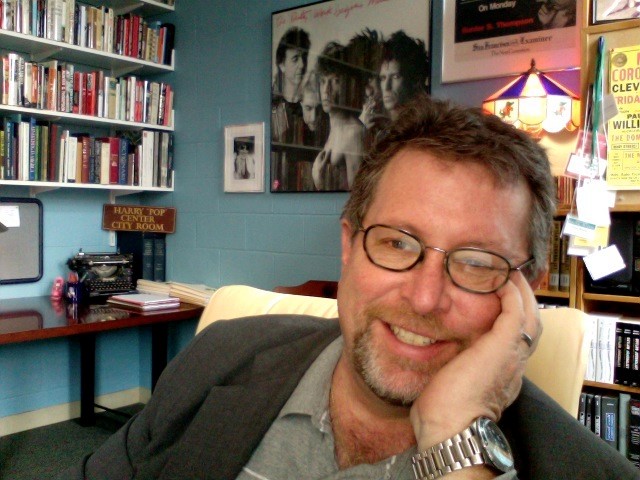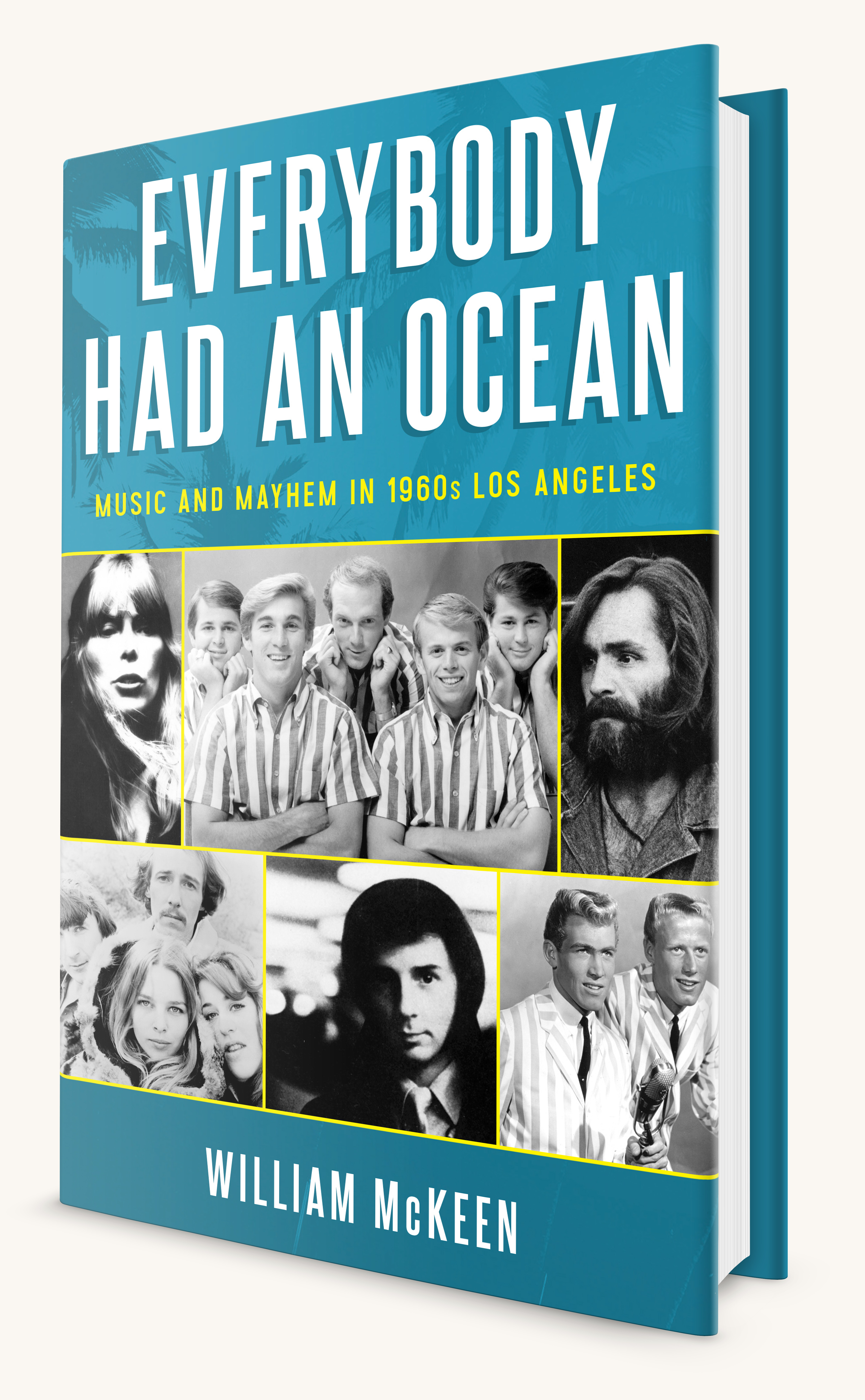 Did you catch ABC’s recent documentary on the Manson murders the other week? How a deranged criminal like Charles Manson walked among Beach Boys and other stars of the era seems almost unimaginable today. His horrific crimes created that pivotal moment in time and place when the bright-eyed naivete felt throughout 1960s Los Angeles quickly turned to terror.
Did you catch ABC’s recent documentary on the Manson murders the other week? How a deranged criminal like Charles Manson walked among Beach Boys and other stars of the era seems almost unimaginable today. His horrific crimes created that pivotal moment in time and place when the bright-eyed naivete felt throughout 1960s Los Angeles quickly turned to terror.
Chicago Review Press’s forthcoming book Everybody Had an Ocean: Music and Mayhem in 1960s Los Angeles by William McKeen covers the Beach Boys, the Manson murders and much, much more.
The book charts the rise of a golden age in rock history, beginning with the migration of the pop music industry to Southern California in the 1960s. In sharp contrast to the endless orgies and squeaky clean surf music that this era brought, many darker undercurrents were at play. Within the seemingly safe social circles of Laurel Canyon occurred kidnappings, ransoms, and murder—the culmination of which, of course, were the infamous Manson murders.
Author William McKeen answers our questions below.
There are a lot of layers behind the title and subtitle of the book. Most people will immediately recognize that it’s a line from the Beach Boys’ song “Surfin’ USA,” but can you break down its deeper meaning a bit in the context of the book?
There’s that meaning — the line from the song that was intended to make surf music all inclusive, a conscious effort on Brian Wilson’s part to make the exuberance of surf music into something that even kids in landlocked states could enjoy. But it’s also a reference to the joy and exuberance and promise of the early sixties and how those things dissipated, to a large degree, by decade’s end. It’s a journey from joy to dread. Maybe “Everybody Had an Ocean” is the rock’n’roll way of saying, “Once there was a spot that was known as Camelot.”
You highlight the era’s sharp contrasts and contradictions as a recurring theme throughout the book. How did such a time of peace, love, and bubbly surf music also become the catalyst for those darker acts of the era—kidnapping, ransom and murder?
Maybe it’s a matter of trust. There was a beautiful and unpretentious side to the young people of the sixties and the music reflected that. Part of that was a willingness to embrace everything with an openness and innocent of prejudice. But the dark underbelly of that is that it led to that “it’s all good” ethos. Late in the book, Bobby Beausoleil, a murderous member of the Manson Family, tells Truman Capote that “it’s all good.” Murder, torture, crime … “it’s all good,” Bobby tells Capote. I think Charles Manson saw the hippies as a bunch of chumps, easily exploited. He got out of prison, saw what the world was like in Haight-Ashbury, and set out to take advantage of the naiveté that was in the DNA of the peace, love and flowers crowd. He looked like just another hippie, but he was not of that species.
The cast of characters in the book is impressive—the Beach Boys, Charles Manson, Jan and Dean, Joni Mitchell, Sam Cooke, Frank Sinatra Jr., the Mamas and the Papas, Elvis Presley, Ike and Tina Turner, and more. Did you come to have a favorite musician’s storyline as you were researching and writing?
I’d been living with these stories all my life. I’ve always cared so much about these artists and their stories. But I think I particularly enjoyed writing the chapter about the kidnapping of Frank Sinatra, Jr. Kidnapping is no laughing matter, of course, and I don’t mean to make light of Frank Jr.’s ordeal — not at all. But the guys that kidnapped him were such clowns. I laughed aloud several times when working on that story. The story of Sam Cooke was heartbreaking. He’s always been one of my favorite singers, but I developed a different view of him while working on this book. I also enjoyed the story of Cass Elliot. She was one of the characters in the book I liked the most. She had such a magnificent voice.
Of all your subjects, you seem to dedicate the most space in the book to Brian Wilson of the Beach Boys. Would you say that’s accurate? Why was he the common thread throughout?
The Beach Boys were there from the beginning to the end, so they were the roots of the story. All those L.A. musicians were connected in one way or another and most of their paths crossed the paths of the Beach Boys. Plus, they started the decade as the sun-tanned All-American boys of the New Frontier, and by the end of the decade one of them was bunking with one of the most vicious criminals of the century. It’s such a dark, twisted story. There’s also the basic contradiction that Brian Wilson wrote these enduring songs celebrating a life that he never lived. He wrote “everybody had an ocean,” but he never seemed to have one.
 The book culminates with Charles Manson and the horror of the Manson family murders. ABC just ran its documentary on Charles Manson. Why do you think there’s suddenly a renewed interest in him and his crimes?
The book culminates with Charles Manson and the horror of the Manson family murders. ABC just ran its documentary on Charles Manson. Why do you think there’s suddenly a renewed interest in him and his crimes?
I think the public by and large has a fascination with serial killers. Look at the movies on deep cable, the crime novels, and all of that stuff. A lot of the young women that I know — people born 30 years after the murders — find entry to the story through Sharon Tate. She was a remarkably beautiful woman who — all these decades later — is something of a style icon. Check her out on Pinterest. Who can hear that story — of a nine-months pregnant woman pleading with her killer for the life of her child — and not be moved? Vincent Bugliosi, who prosecuted the Manson killers, made an interesting point. We don’t call these crimes the Tate murders. They are the Manson murders. Manson stole the identities of his victims.
Bonus Content:

We asked William if he would compile a playlist of songs for the book that we could share here. See his picks below—and see the playlist on iTunes here (opens in iTunes).
Here it is—the best of LA rock in the Sixties, and two bonus tracks. As they would say back in the day, “Dig it!”
“Sloop John B”— This is the backing track, no vocals, and should rightly be credited to the Wrecking Crew.
“You Baby”— Written by teenage P.F. Sloan, who wrote a bunch of surfing songs (“Summer Means Fun,” among others) and recorded as the Fantastic Baggys and the Super Stocks. He later wrote “Eve of Destruction.”
“Be My Baby”
“You’ve Lost that Lovin’ Feelin’”
“River Deep, Mountain High”— These are all Phil Spector productions. “River Deep” should rightly be credited to Tina Turner; Ike did not play on it.
“Dream a Little Dream” — Though credited to the Mamas and the Papas, this is Cass Elliot solo.
“Summer’s Gone”— The only non-1960s song is this concluding track, because it figures into the book’s epilogue.
Plus, two bonus tracks, for the curious:
“Never Learn Not to Love” by the Beach Boys (co-written by an uncredited Charles Manson)
“Look at Your Game, Girl” by Charles Manson
Everybody Had an Ocean: Music and Mayhem in 1960s Los Angeles arrived on shelves on April 1, 2017 and is available wherever books and e-books are sold.
No Comments
No comments yet.